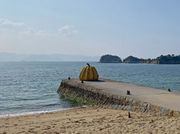Japanese architect Tadao Ando is known for his visionary designs that consider the interplay of light, scale, and water in built spaces. Designing a broad range of structures—from residential housing to major international museums—Ando's buildings maintain a distinct contextual and material sensitivity that reflects his holistic approach to architecture.
Read MoreBorn in Osaka, Ando initially trained as a boxer, and is self-taught as an architect.
While travelling in his youth, Ando saw buildings designed by architects such as Le Corbusier and Frank Lloyd Wright, which inspired him to pursue architecture. He sought informal training for drawing and interior design, and undertook apprenticeships with industry tradespeople.
In 1968, he established Tadao Ando Architect and Associates in Osaka, and steadily gained recognition for his residential housing designs. Features of early small scale builds such as the Azuma House (1976) and the Koshino House (1984), including the use of parallel planes and exposed concrete, would become hallmarks of Ando's architectural practice.
Tadao Ando's designs are characterised by their innovative integration of natural light and their prolific use of reinforced concrete for both structure and aesthetic. The silky smooth surface of his cast concrete is achieved through meticulously crafted wooden form moulds that have an additional layer of varnish applied. Ando's attentiveness to the framing of light and space generates a spatial harmony in his structures, rendering the concrete's presence effortless, minimal, and balanced.
Ando states: 'I create enclosed spaces mainly by means of thick concrete walls. The primary reason is to create a place for the individual, a zone for oneself within society. When the external factors of a city's environment require the wall to be without openings, the interior must be especially full and satisfying. ... Such things as light and wind only have meaning when they are introduced inside a house in a form cut off from the outside world. I create architectural order on the basis of geometry squares, circles, triangles and rectangles. I try to use forces in the area where I am building, to restore the unity between house and nature (light and wind) that was lost in the process of modernising Japanese houses during the rapid growth of the fifties and sixties.'
Towards the end of the 1980s, Ando began to work more in settings surrounded by nature, as opposed to the urban regions he designed for during the 1960s and 70s. This enabled him to develop an approach that saw architecture integrated harmoniously into landscapes to complement the environment and highlight its unique features.
Ando's Church on the Water (1988) in Hokkaido exemplifies these principles. Built upon a sloping clearing within a beech forest near a small river, the chapel appears to float above a pond. Similarly, The Church of the Light (1989) in Ibaraki, Osaka demonstrates Ando's use of concrete to shape space and filter natural light to enhance the purpose of a building.
Ando is recognised for his multifaceted approach to architectural practice and consideration for the wider social and environmental contexts of his designs. His commitment to environmental restoration, community development, and social and cultural activity in relation to his builds has distinguished Ando's practice from purely design-oriented architecture.
As Ando gained widespread international acclaim, he was increasingly engaged to design and remodel major projects worldwide—in particular art galleries, museums, and places of worship. Ando's first project in the United States was completed in 1992 at the Art Institute of Chicago. The Ando Gallery (Gallery 109) incorporated the influence of traditional Japanese design, with 16 thick wooden columns standing within the space to subtly frame viewers' experience of the artworks.
Notable international projects include the Pulitzer Arts Foundation, Missouri (2001); Modern Art Museum of Fort Worth, Texas (2002); The Stone Hill Center, Massachusetts (2008); Punta della Dogana, Venice (2009); Asia Museum of Modern Art, Taichung (2013); Aurora Museum, Shanghai (2013); Jaeneung Culture Center (JCC), Seoul (2015); Wrightwood 659, Chicago (2018); and He Art Museum, Guangdong (2020).
Ando's 'Malibu House' (2013), a residential beach house in California formerly known as the Richard Sachs Residence, gained significant attention in 2021 when it was purchased by rapper Kanye West.
Further renowned designs in Japan include the Suntory Museum, Osaka (1994); The Oval at Benesse Art Museum, Naoshima (1995); Hyogo Prefectural Museum of Art, Kobe (2002); 4x4 House, Kobe (2003); Chichu Art Museum, Naoshima (2004); and the Shibuya Station, Tokyo (2008), among many others.
Ando has taught as a visiting professor at major universities including Harvard, Yale, and Columbia. Since 2003, he has been a Professor Emeritus at the University of Tokyo.
Ando has received numerous awards over his career, including the Architectural Institute of Japan (AIJ) Prize (1979), Pritzker Architecture Prize (1995), International Union of Architects Gold Medal (2005), John F. Kennedy Center Gold Medal in the Arts (2010), Shimpei Goto Award (2010), Order of Culture (Japan) (2010), Commander of the Order of Art and Letters (France) (2013), Grand Officer of the Order of Merit (Italy) (2015), and Isamu Noguchi Award (2016).
Tadao Ando's website can be found here.
Misong Kim | Ocula | 2022




